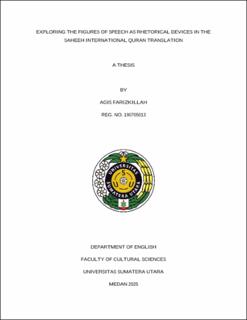Exploring The Figures of Speech as Rhetorical Devices in The Saheeh International Quran Translation

Date
2025Author
Farizkillah, Agis
Advisor(s)
Rangkuti, Rahmadsyah
Syahputra, Fikry Prastya
Metadata
Show full item recordAbstract
This thesis aims to analyze the figures of speech as rhetorical devices within the Saheeh International translation of Surah Al-Baqarah, motivated by the necessity for effective cross-cultural communication and interpretation analysis of the Quran in the recent globalized world. The research objectives are to identify and categorize various figures of speech in the translation and analyze the associated rhetorical appeals (ethos, pathos, and logos). Using a descriptive-qualitative method, the study identified 242 instances of figures of speech, categorized into ten types: parallelism, antithesis, descriptio, metonym, rhetorical questions, euphemism, epithet, synecdoche, metaphor, and simile. These elements enhance the clarity, coherence, and impact of the message through repetition, contrast, and descriptions in the selected Quran chapter translation. The analysis of rhetorical appeals revealed the use of ethos, pathos, and logos. Ethos appeals, which emphasize the message's credibility are most prevalent, followed by pathos, which bring out emotional responses, and logos, which appeals to logic. Some figures of speech employ a combination of these appeals, enhancing their persuasive effect. The result of this study shows that the Saheeh International translation of Surah Al-Baqarah blends figures of speech within their appeals as rhetorical devices. By identifying and categorizing various figures of speech, analyzing their rhetorical appeals, and highlighting their strategic use, this study showcases the translation's ability to maintain the Quran's linguistic and rhetorical excellenc, showing how the figures of speech act as rhetorical devices in the Quran translation by Saheeh International.
Collections
- Undergraduate Theses [873]
